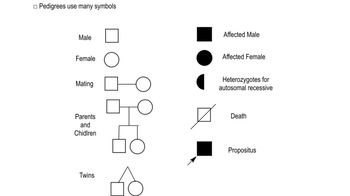Table of contents
- 1. Introduction to Genetics51m
- 2. Mendel's Laws of Inheritance3h 37m
- 3. Extensions to Mendelian Inheritance2h 41m
- 4. Genetic Mapping and Linkage2h 28m
- 5. Genetics of Bacteria and Viruses1h 21m
- 6. Chromosomal Variation1h 48m
- 7. DNA and Chromosome Structure56m
- 8. DNA Replication1h 10m
- 9. Mitosis and Meiosis1h 34m
- 10. Transcription1h 0m
- 11. Translation58m
- 12. Gene Regulation in Prokaryotes1h 19m
- 13. Gene Regulation in Eukaryotes44m
- 14. Genetic Control of Development44m
- 15. Genomes and Genomics1h 50m
- 16. Transposable Elements47m
- 17. Mutation, Repair, and Recombination1h 6m
- 18. Molecular Genetic Tools19m
- 19. Cancer Genetics29m
- 20. Quantitative Genetics1h 26m
- 21. Population Genetics50m
- 22. Evolutionary Genetics29m
2. Mendel's Laws of Inheritance
Pedigrees
Problem 47c
Textbook Question
The accompanying pedigree shows a family in which one child (II-1) has an autosomal recessive condition. On the basis of this fact alone, provide the following information.
What are the probabilities for each of the possible genotypes for II-2, II-3, and II-4?
 Verified step by step guidance
Verified step by step guidance1
<span>Step 1: Understand the inheritance pattern. Since the condition is autosomal recessive, an individual must inherit two copies of the recessive allele (aa) to express the condition. Carriers have one dominant and one recessive allele (Aa), and unaffected individuals with no recessive allele have two dominant alleles (AA).</span>
<span>Step 2: Analyze the pedigree. Individual II-1 is affected, meaning their genotype is aa. This indicates that both parents (I-1 and I-2) must be carriers (Aa) because they have passed on the recessive allele to their child.</span>
<span>Step 3: Determine the possible genotypes for II-2, II-3, and II-4. Since both parents are carriers (Aa), each child has a 25% chance of being affected (aa), a 50% chance of being a carrier (Aa), and a 25% chance of being unaffected (AA).</span>
<span>Step 4: Calculate the probabilities for II-2. Since II-2 is not affected, they cannot be aa. Therefore, they have a 2/3 chance of being a carrier (Aa) and a 1/3 chance of being unaffected (AA).</span>
<span>Step 5: Apply the same logic to II-3 and II-4. Assuming they are also unaffected, each has a 2/3 chance of being a carrier (Aa) and a 1/3 chance of being unaffected (AA).</span>
Recommended similar problem, with video answer:
 Verified Solution
Verified SolutionThis video solution was recommended by our tutors as helpful for the problem above
Video duration:
1mPlay a video:
Was this helpful?
Key Concepts
Here are the essential concepts you must grasp in order to answer the question correctly.
Autosomal Recessive Inheritance
Autosomal recessive inheritance occurs when a trait or condition is expressed only when an individual has two copies of the recessive allele, one inherited from each parent. In this case, if a child has an autosomal recessive condition, both parents must be carriers of the recessive allele, even if they do not express the condition themselves.
Recommended video:
Guided course

Autosomal Pedigrees
Pedigree Analysis
A pedigree is a diagram that depicts the genetic relationships within a family over generations. It helps in tracking the inheritance of traits and can reveal patterns of inheritance, such as whether a condition is autosomal dominant or recessive, by analyzing the affected and unaffected individuals in the family.
Recommended video:
Guided course

Pedigree Flowchart
Genotype Probabilities
Genotype probabilities refer to the likelihood of an individual inheriting a specific combination of alleles from their parents. In the context of the pedigree, calculating the probabilities for genotypes of II-2, II-3, and II-4 involves using the known genotypes of their parents and applying principles of Mendelian genetics to determine the chances of each possible genotype.
Recommended video:
Guided course

Probability

 2:48m
2:48mWatch next
Master Pedigree Symbols with a bite sized video explanation from Kylia Goodner
Start learning


